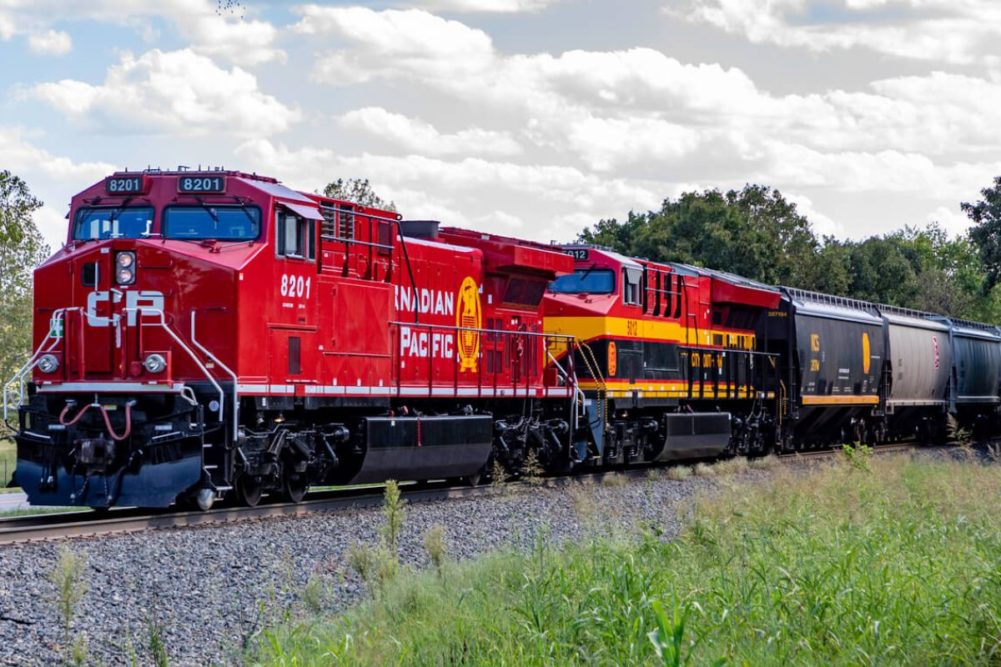KANSAS CITY, MISSOURI, US — Although it may need to go “a little backwards to go forward,” the grain business of Canadian Pacific Kansas City Ltd. (CPKC) is primed to be a huge part of the newly combined company’s operations, accounting for 30% of CPKC’s revenues in the future, said John K. Brooks, executive vice president and chief marketing officer, during a June 28 investor day conference call.
“In the (investor day) I participated in back in 2015 … I said we’re going to try to bring sexy back to grain,” Brooks said. “I know it’s pathetic, and it’s taken a long time to get anywhere near remote to that. But if you now picture this, putting together these two franchises, there’s no way independently we could do in grain what bringing these two together will be able to create. That’s as good as I can get for sexy.”
Brooks said the CPKC franchise has 135 existing elevators across the prairies of Canada in the Upper Midwest. Through the combination with Kansas City Southern Railway earlier this year the new CPKC is now able to link to a destination network that goes beyond Kansas City, a “powerful thing,” said Brooks.
“It’s the ability for grain marketers to now be able to send products directly down to the poultry feeders or the cattle feeders across Mississippi, Louisiana, Alabama,” he said. “It’s the ability for exporters to now pull grain out of North Dakota or Southern Saskatchewan down to Houston or the Galveston area to export grain, or it’s the ability to go down into Mexico. Mexico imports 30 million tonnes of grain annually. It’s the biggest trade grain partner with the US. It just actually moved slightly in front of China.”
Brooks said that during the company’s first 75 days as CPKC it has noticed the grain industry beginning to trade and display signs of being a matchmaker.
“It’s sort of like this game where they’ve now got all these different Plinko pieces and how do you put together and make these grain flows happen,” he said. “As of a couple of weeks ago, we’ve seen 12 new origin and destination pairs just begin to merge with grain flows. I’ll give you an example. Like I just saw yesterday, train of corn going from Elbow Lake, Minnesota, US, down to Mexico City. I saw Weyburn, Saskatchewan, train of wheat going down to St. Louis (Missouri, US). And in this case, this is nothing my sales team is doing. Look, not that we’re out not selling what the power of this franchise could be and planting these seeds across it. This is truly the thousands of other grain trader salespeople out there that are now taking this network and trying to put these puzzle pieces together to create more value in this ag supply chain.”
Brooks estimated there will be 5 million to 7 million tonnes of new crush capacity built across Canada — all in CPKC’s backyard. CPKC’s goal will be to pull that canola out of its competitors’ territory and into those crush facilities, and then to take the oil out of those plants and ship it to destination terminals. Ultimately the market will trickle down into the southern United States and Mexico, creating a “powerful opportunity,” Brooks said.
This network is set to combine with CPKC’s 8,500-foot High Efficiency Product (HEP) model to drive further investment in the company’s ag and grain space.
“These 8,500-foot trains are creating and carrying about 44% more capacity, more grain per train from origin to destination,” Brooks said of the HEP model first introduced in 2018. “But on top of that, if you begin to look at the cycle times of those trains versus our legacy trains that we use to haul, they’re running at about a 30% faster cycle time. This model is unlocking resiliency for the grain industry, It’s unlocking capacity, and it’s unlocking more investments.
“We had six 8,500-foot facilities when we introduced this model back in 2018. By this time next year, we’re going to have 66 of those facilities across our network. And not only Canada: We’ll have them across Canada, we’ll have them across the United States and we’ll have them down into Mexico.”
Brooks took time during the call to discuss CPKC’s relationship with some of the grain industry giants, and how the new network is better able to serve their needs.
In the case of ADM, he said CPKC is building a line that will connect ADM’s crush facility in Deerfield, Missouri, US, with its buyers in Minnesota, North Dakota, Iowa, Wisconsin and other northern locations. That product then will be able to be shipped by ADM to feeders down in Mexico, Brooks said.
“It creates this complete ecosystem for that crush plant at Deerfield,” he said.
He also noted during the call that Viterra, which is set to merge with Bunge Ltd., is the single largest 8,500-foot shipper across the CPKC network. He said Viterra has 21 existing facilities with four more in the pipeline for 2023.
“They are experienced and actually completely have been the fastest to leverage our 8,500-foot network across our grain companies,” Brooks said. “So we’re working currently with Viterra to bring that model given their combination most recently with Gavilon, and now most recently, their announcement to merge with Bunge to take that model that they’ve created up in Canada and redeploy it and develop it across the Midwest and then also down into Mexico.”






